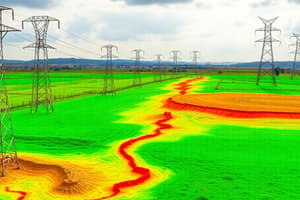Podcast
Questions and Answers
Which type of unsymmetrical fault is considered the most severe?
Which type of unsymmetrical fault is considered the most severe?
- Double Line-to-Ground (L-L-G) Fault
- Line-to-Ground (L-G) Fault
- Line-to-Line (L-L) Fault
- Three-Phase-to-Ground (LLL-G) Fault (correct)
In the sequence equations, what does the term Va0 represent?
In the sequence equations, what does the term Va0 represent?
- Positive sequence voltage
- Negative sequence voltage
- Fault current
- Zero sequence voltage (correct)
What is the purpose of the sequence impedance network?
What is the purpose of the sequence impedance network?
- To calculate ground resistance
- To analyze total fault current
- To assess power factor corrections
- To describe balance equivalent network (correct)
Which equation is used to describe the fault under consideration?
Which equation is used to describe the fault under consideration?
What does the symbol 'Ea' represent in the sequence equations?
What does the symbol 'Ea' represent in the sequence equations?
Unsymmetrical faults can occur due to which of the following factors?
Unsymmetrical faults can occur due to which of the following factors?
Which type of fault includes both line-to-line and line-to-ground components?
Which type of fault includes both line-to-line and line-to-ground components?
In unsymmetrical fault analysis, what are the two sets of equations primarily used for?
In unsymmetrical fault analysis, what are the two sets of equations primarily used for?
Which unsymmetrical fault type is analyzed last in terms of severity?
Which unsymmetrical fault type is analyzed last in terms of severity?
What does the sequence network aid in during fault analysis?
What does the sequence network aid in during fault analysis?
What is the primary function of the positive sequence network in fault analysis?
What is the primary function of the positive sequence network in fault analysis?
Which statement accurately describes the fault impedance in a power system?
Which statement accurately describes the fault impedance in a power system?
What does the zero sequence fault impedance represent?
What does the zero sequence fault impedance represent?
How do unsymmetrical faults affect the power system?
How do unsymmetrical faults affect the power system?
In fault analysis, what role does the Thevenin equivalent circuit play?
In fault analysis, what role does the Thevenin equivalent circuit play?
What happens to the fault current as the fault impedance increases?
What happens to the fault current as the fault impedance increases?
Why is it important to understand fault impedance during fault analysis?
Why is it important to understand fault impedance during fault analysis?
What characterizes the negative sequence network in relation to the positive sequence network?
What characterizes the negative sequence network in relation to the positive sequence network?
What is a crucial factor in the design of protective systems in relation to fault impedance?
What is a crucial factor in the design of protective systems in relation to fault impedance?
Which type of fault can be analyzed using symmetrical components?
Which type of fault can be analyzed using symmetrical components?
What is the primary advantage of using symmetrical components in unsymmetrical fault analysis?
What is the primary advantage of using symmetrical components in unsymmetrical fault analysis?
Which of the following factors can influence the occurrence of unsymmetrical faults?
Which of the following factors can influence the occurrence of unsymmetrical faults?
When analyzing unsymmetrical faults, which key element is represented by Ia1 in the sequence equations?
When analyzing unsymmetrical faults, which key element is represented by Ia1 in the sequence equations?
What is the significance of the sequence impedances Z0, Z1, and Z2 in fault analysis?
What is the significance of the sequence impedances Z0, Z1, and Z2 in fault analysis?
In the context of sequence networks, what does the term 'c.u.f.' refer to?
In the context of sequence networks, what does the term 'c.u.f.' refer to?
During unsymmetrical fault analysis, which type of fault typically involves the highest severity on the power system?
During unsymmetrical fault analysis, which type of fault typically involves the highest severity on the power system?
What is primarily assessed with the positive sequence network in a power system?
What is primarily assessed with the positive sequence network in a power system?
Why are the sequence networks essential in unsymmetrical fault analysis?
Why are the sequence networks essential in unsymmetrical fault analysis?
Which statement accurately describes the sequence equations in the context of unsymmetrical fault analysis?
Which statement accurately describes the sequence equations in the context of unsymmetrical fault analysis?
What is the purpose of analyzing faults at the terminals of an unloaded generator?
What is the purpose of analyzing faults at the terminals of an unloaded generator?
What is the main characteristic of a positive sequence network during symmetrical fault analysis?
What is the main characteristic of a positive sequence network during symmetrical fault analysis?
Which statement correctly describes the relationship between current and fault point during a fault condition?
Which statement correctly describes the relationship between current and fault point during a fault condition?
What does zero sequence fault impedance (Z0) represent?
What does zero sequence fault impedance (Z0) represent?
How does fault impedance affect the fault current in a power system?
How does fault impedance affect the fault current in a power system?
Why are symmetrical components important in analyzing unsymmetrical faults?
Why are symmetrical components important in analyzing unsymmetrical faults?
What does the Thevenin equivalent circuit represent in the context of sequence networks?
What does the Thevenin equivalent circuit represent in the context of sequence networks?
Which of the following correctly categorizes fault impedance?
Which of the following correctly categorizes fault impedance?
What key aspect must be understood to assess the impact of faults on system stability?
What key aspect must be understood to assess the impact of faults on system stability?
During unsymmetrical faults, what happens to the bus voltages?
During unsymmetrical faults, what happens to the bus voltages?
What is a characteristic of the negative sequence network?
What is a characteristic of the negative sequence network?
Flashcards
Unsymmetrical Fault Analysis
Unsymmetrical Fault Analysis
Analysis of faults in electrical power systems where the fault involves unequal currents or voltages in different phases.
L-G Fault
L-G Fault
A line-to-ground fault, considered a less severe fault.
L-L Fault
L-L Fault
A line-to-line fault, less severe than a double line-to-ground fault.
L-L-G Fault
L-L-G Fault
Signup and view all the flashcards
Symmetrical Components
Symmetrical Components
Signup and view all the flashcards
Sequence Equations
Sequence Equations
Signup and view all the flashcards
Sequence Networks
Sequence Networks
Signup and view all the flashcards
Positive Sequence Network
Positive Sequence Network
Signup and view all the flashcards
Fault at Generator Terminals
Fault at Generator Terminals
Signup and view all the flashcards
Fault at any point F
Fault at any point F
Signup and view all the flashcards
Three-sequence Networks
Three-sequence Networks
Signup and view all the flashcards
Positive Sequence Network
Positive Sequence Network
Signup and view all the flashcards
Negative Sequence Network
Negative Sequence Network
Signup and view all the flashcards
Zero Sequence Network
Zero Sequence Network
Signup and view all the flashcards
Symmetrical Components
Symmetrical Components
Signup and view all the flashcards
Thevenin's Equivalent Circuit
Thevenin's Equivalent Circuit
Signup and view all the flashcards
Fault Impedance
Fault Impedance
Signup and view all the flashcards
Positive Sequence Fault Impedance (Z1)
Positive Sequence Fault Impedance (Z1)
Signup and view all the flashcards
Zero Sequence Fault Impedance (Z0)
Zero Sequence Fault Impedance (Z0)
Signup and view all the flashcards
Fault Current
Fault Current
Signup and view all the flashcards
Unsymmetrical Fault Analysis
Unsymmetrical Fault Analysis
Signup and view all the flashcards
Sequence Equations
Sequence Equations
Signup and view all the flashcards
Sequence Networks
Sequence Networks
Signup and view all the flashcards
L-G Fault
L-G Fault
Signup and view all the flashcards
L-L Fault
L-L Fault
Signup and view all the flashcards
L-L-G Fault
L-L-G Fault
Signup and view all the flashcards
Fault at Generator Terminals
Fault at Generator Terminals
Signup and view all the flashcards
Fault Current (If)
Fault Current (If)
Signup and view all the flashcards
Symmetrical Components
Symmetrical Components
Signup and view all the flashcards
Positive Sequence Network
Positive Sequence Network
Signup and view all the flashcards
Sequence Networks
Sequence Networks
Signup and view all the flashcards
Positive Sequence Network
Positive Sequence Network
Signup and view all the flashcards
Negative Sequence Network
Negative Sequence Network
Signup and view all the flashcards
Zero Sequence Network
Zero Sequence Network
Signup and view all the flashcards
Fault Impedance
Fault Impedance
Signup and view all the flashcards
Fault Current
Fault Current
Signup and view all the flashcards
Symmetrical Components
Symmetrical Components
Signup and view all the flashcards
Thevenin's Equivalent Circuit
Thevenin's Equivalent Circuit
Signup and view all the flashcards
Positive Sequence Fault Impedance (Z1)
Positive Sequence Fault Impedance (Z1)
Signup and view all the flashcards
Zero Sequence Fault Impedance (Z0)
Zero Sequence Fault Impedance (Z0)
Signup and view all the flashcards


